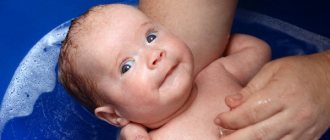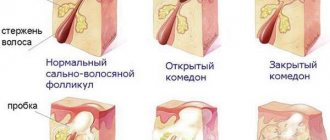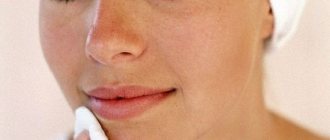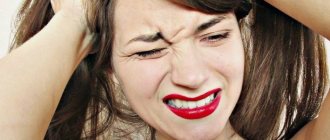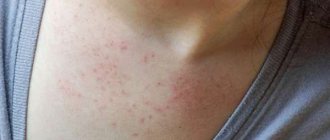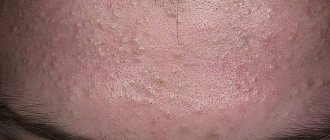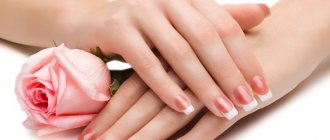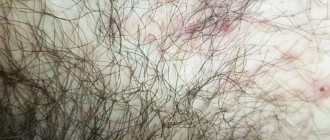- Causes of acne in a girl or boy aged 11-12 years
- Improper diet causes acne in boys, girls 11 - 12 years old
- How to get rid of acne in a child aged 11-12 years
Indeed, although on the one hand it may seem early, acne can still appear in a child, be it a boy or a girl, as early as 11 - 12 years old. For some, puberty may begin so early, and for others Acne can be caused by natural factors and reasons which we will talk about in this post.
The concept of acne: why they appear
First you need to understand that pimples never appear just like that. This is a sign of some kind of problem in the body. For example, from the age of 10 or 12, the so-called period of growing up begins. It is during adolescence that most young people first encounter the problem of acne on the forehead. This occurs due to a surge in hormones; a similar situation occurs during menstruation, pregnancy and after childbirth.
Small pimples on the forehead, scattered, mean problems with the genitourinary system. Sometimes, inflammation and craters on the forehead appear from bangs (especially in summer), more precisely due to the fact that the skin is poorly ventilated and sweats. If the pimples itch, then this is definitely an allergy; their treatment requires consultation with a specialist.
Pimples on forehead
Do you consider yourself superstitious? We have also prepared several “specific reasons” for the appearance of acne:
- Do white and inflamed pimples appear on the forehead and bridge of the nose? – This means that someone has fallen in love and longs for a relationship;
- the dream book says that pimples that pop up on Friday and Monday mean good luck, and on Tuesday - good luck;
- If, in addition to the forehead, acne appears on the cheeks and chin, then there is a possibility of a negative impact.
Acne on the face of a 1-2 year old child
Poll: When did your acne appear? (Number of votes: 4295)
I've been suffering all my life
It's been a couple of years now
About a few months
Recently
To vote, click on the desired answer. results
There are many reasons why children develop acne on the face. We have prepared for you descriptions of the main diseases that can cause acne on the face in a 1-2 year old child, although it is possible that similar diseases may appear in children up to 8 years of age, and in rare cases, even up to 10 years of age.
We divided the diseases into 2 categories, among which we will tell you about the reasons for the appearance of red, as well as white, purulent pimples.
Treatment of frontal acne
1) If the pimples on the forehead are isolated, then you can try to cure them with toothpaste. Just apply the paste to problem areas and leave it until the morning. There may be a slight burning sensation, but in this way you can relieve severe inflammation overnight.
2) Soda solution will help get rid of small pimples on the forehead. It is recommended to use it once a day, regularly. Dilute a spoonful of soda, three drops of iodine and half a spoonful of sea salt in a glass of water, wipe the dermis with this liquid; if desired, you can use it on the legs and back.
3) A cucumber will help get rid of a lot of incipient acne on the forehead. Just cut the cucumber into thin slices and apply pieces of the vegetable to the damaged skin. After 20 minutes, turn over to the opposite side. This method will help remove primary signs, refresh the skin and treat inflammation.
4) You can easily get rid of inflamed acne at home using salicylic acid and zinc paste. The components can be bought at the pharmacy, they need to be mixed and applied to the pimples, but not in a uniform layer, but in a targeted manner. This method will help to quickly burn down acne and pimples and get rid of minor rashes. Use once every 3 days.
5) How to quickly get rid of acne on the forehead at home using home remedies? There is one very effective method. In one day it helps with subcutaneous acne and rashes in a teenager. Mix blue clay (two spoons), water (spoon), lemon juice (spoon), cucumber puree, aloe juice in a non-metallic bowl. Mix everything and apply to face until it hardens. In general, mineral masks are good for treating both subcutaneous and purulent and red boils on the face.
Active acidic components help a lot against purulent acne. For successful treatment, you need to remove the top damaged layer of skin, this can be done at home in 1 day, there are simple and very effective recipes.
6) One of them is to wipe your face with grape juice, then treat your skin with an almond scrub. Purulent acne from such exposure will disappear almost immediately.
7) The next method is to cleanse the skin using an alginate mask.
It is impossible not to write about mechanical cleaning. No matter what they tell us about its harm, we still cannot resist the temptation to squeeze out our pimples, at least occasionally. For this procedure to be truly effective, and then not have to get rid of scars on your face, you need to know a few rules :
- if pimples on the forehead indicate hormonal imbalances, there is simply no point in squeezing them;
- always wash your hands and face with soap before the procedure;
- in order to squeeze out small pimples, you need to use special devices, for example, cosmetic needles or “nets” (we pre-treat the devices with alcohol);
- do not squeeze subcutaneous pimples yourself;
- After the procedure, be sure to treat your skin with a soothing lotion.
Treatment of other acne
Girls often develop cold pimples , getting rid of which can take a long time. It is logical that after recovery they will go away, but what if the rehabilitation process is delayed? A mask of sour cream and oatmeal will help us. Mix the ingredients, let them brew for 30 minutes, then apply to the skin and leave for 30 minutes.
In spring, acne is a very common occurrence; it is a sure sign of vitamin deficiency. In order to cure these painful rashes you need:
- take vitamins (preferably complex, not separate groups);
- walk more in the fresh air;
- thoroughly clean your face with a sugar or coffee scrub;
- make masks from fruits and berries, in particular strawberries, raspberries, apricots.
If it is not completely clear why acne appears on the forehead, it is best to consult a specialist; the reason can be quite serious, ranging from a lack of certain essential substances in the body to severe chronic diseases.
If acne breaks out in men, then this is a possible sign of allergic reactions or stoppage of the prostate gland. Try burning them with paste, a solution of calcium and ascorbic acid, or lemon juice.
Children and acne
Many mothers, from the very birth of their baby, begin to struggle with acne. Even if the pregnancy proceeded normally, there is a possibility that the baby was still missing something in the womb; the conclusion is to determine what and make up for this deficiency.
Acne in babies often occurs due to increased sweat production. In this case, acne will appear on the temples and nose. You can only remove them by dryness, bathe your baby more often, wipe his face with a slice of cucumber, if the pimples are wet, sprinkle them with powder, if they don’t go away, we recommend using children’s “Panthenol” or “Bepanten”. You can easily remove prickly heat in children on the inner thigh and forehead in a simple way: just wash these areas with saline solution and sprinkle with starch.
Internal acne in a child indicates improper functioning of the endocrine and excretory systems. Cleansing the body will help here; perhaps you need to arrange a fasting day, limit or completely eliminate sweets, fried foods and fast food. They need to be bandaged with ichthyola or Vishnevsky ointment. What to do if an abscess forms at the site of a pimple? Wash the wound and apply zinc paste to the damaged area.
We hope our tips told you how to get rid of acne on your forehead. Before choosing how to deal with this problem, it is advisable to consult a doctor, donate blood and urine for analysis, these actions will help identify the cause of the malfunction of the body. Remember, the problem is easier to avoid, so you will need prevention; reconsider your diet and lifestyle; for consultation and selection of a suitable method of treating the problem, you can visit our forum.
Recommended publications on the topic:
Many people experience rashes on the forehead because this area contains a large number of sebaceous glands. Pimples look unsightly and greatly spoil your appearance. Of course, you can disguise imperfections with makeup or try to cover your forehead with long bangs. But it’s better to try to get rid of acne, especially since there are different skin care methods.
What are the dangers of purulent acne in a child?
Children's skin is very sensitive, so it is forbidden to squeeze pimples. After squeezing, a diseased, purulent pimple may leave a scar, or in the worst case, the rash will spread to nearby areas.
The main danger for the child is the rapid spread of infection, so it is forbidden to touch the rash. When infected, germs will begin to spread throughout the body through the bloodstream.
Often, purulent acne in a child requires consultation with a doctor and special treatment, as it is caused by infectious pathologies.
Causes of acne formation
By eliminating the causes of acne, the problem itself is eliminated.
The skin of the forehead belongs to the T-zone; there are many sebaceous and sweat glands in this area, and increased secretion of fat and sweat creates favorable conditions for the development of bacteria. Therefore, inflammation on the skin of the forehead occurs frequently.
Factors that provoke the appearance of rashes:
- Incorrect care. Insufficiently thorough cleansing of the skin, the use of low-quality cosmetics, too heavy makeup - all this leads to clogged pores and the development of inflammation.
- Poor nutrition. The condition of the skin depends on the choice of products. Too many sweets, fatty foods and spicy seasonings have a bad effect not only on your figure, but also on your skin.
- Hormonal imbalances. When hormone levels change, the activity of the sebaceous glands changes. For this reason, teenagers, women during menstruation and pregnancy often experience acne on the forehead. Pimples are especially common due to pathological hormonal imbalances, for example, if women produce too many male hormones.
- Gastrointestinal diseases. The condition of the skin is directly related to the functioning of the digestive system. Pimples located close to the hairline may indicate problems with the gallbladder and liver. Inflammation in the eyebrow area is a symptom of intestinal diseases.
- External influence. Constant irritation of the skin on the forehead can lead to acne. It can occur when wearing poorly chosen headwear.
What to do if acne appears on your forehead?
The best decision when different types of rashes appear on the forehead is to consult a doctor. After all, this problem may indicate the presence of hormonal or other disorders in the body. Pimples in a teenager often leave behind scars and pits, which spoils the beauty of the face. And only a cosmetologist can help correct the situation.
It is not recommended to self-medicate, because the wrong drugs can only worsen the situation.
What tests will be required?
First, the doctor will ask questions about your lifestyle, diet, and recent stress. He may order the following tests:
- blood test for viruses and bacteria, hormones, sugar and antibodies;
- general urine test for sugar;
- stool analysis to identify worms.
Women may be prescribed an ultrasound to diagnose the uterus and appendages, since in certain female pathologies hormonal levels are disrupted, which leads to the formation of acne.
It is important for the doctor to know about the stress the patient has suffered, since the nervous system may need to be restored, and the acne problem will go away on its own.
What medications are used
Depending on the cause, the doctor will recommend the following medications to take by mouth:
- if bacteria are present, antibiotics are prescribed;
- if suspicions of the presence of helminths and protozoa are confirmed, antiparasitic drugs are used;
- medications to restore intestinal microflora;
- drugs that restore kidneys and liver;
- for diabetes mellitus, hypoglycemic agents are prescribed;
- stress and nervous tension are treated with antidepressants and sedatives;
- in case of hormonal imbalance, hormonal drugs are prescribed individually;
- drugs for the treatment of the thyroid gland.
If a tumor is present, treatment is surgery, radiation, or chemotherapy. The main goal of the doctor is to rid the patient of the cause that influenced the occurrence of acne on the forehead.
External treatment methods
Most often, creams, gels and lotions are used to combat facial rashes. A mild form of the rash can be quickly eliminated by the following means:
- antibiotic (Zinerit, Levmekol);
- antiseptic ointments (ichthyol);
- hormonal drugs (hydrocortisone).
It is important to remember that antibiotics affect not only pathogenic but also beneficial bacteria. Antiseptics dry out the face greatly, which can result in itching.
Types of rashes
There are the following types of rashes on the forehead:
- Comedones are non-inflammatory formations caused by clogging of the pores with sebum. May rise slightly above the surface of the skin.
- Millet or milia. These are closed comedones, they look like small nodules of white or yellowish color without signs of inflammation.
- Papules are red inflammatory formations that rise above the skin.
- Pustules are cavities filled with pus.
- Nodes are deeply located inflammatory foci that look like subcutaneous bumps
- Cysts and conglomerates are large inflamed areas connected to each other by fistulous tracts.
Types of rashes on the face in children of different ages
As already noted, the rash can be primary or secondary. Primary rashes are of greatest interest because they are the most common. It is with their diagnosis that difficulties arise. Based on shape and appearance, the following varieties are distinguished:
- Tubercles are non-hollow lumps on the skin.
- Blisters are dense areas that rise above the level of healthy skin. Blisters are an allergic reaction to poison from plants and insects.
- Papules, or nodules, are non-hollow elements that differ in height and color from healthy skin. They usually go away on their own.
- Bubbles are small pimples. They have a pronounced center filled with cloudy liquid.
- Bubbles are large formations (from 0.5 cm).
- Pustules are pimples filled with pus.
- Spots are changes in the color of the skin.
- Roseola are small pink or red spots that disappear when you apply pressure to the affected area.
Teenage acne
Teenage acne is a widespread phenomenon. Few people manage to avoid skin problems during puberty. The main reason for the formation of rashes is hormonal changes. Due to changes in hormonal status, the sebaceous glands begin to work harder, which causes an increase in skin oiliness. And sebum is an excellent breeding ground for bacteria.
Many people believe that it is useless to fight teenage acne, saying that it will go away on its own with age. This is a fundamentally wrong opinion. Firstly, inflamed rashes negatively affect appearance, which creates psychological problems. Secondly, large inflammations can leave scars on the skin, which will then be difficult to get rid of.
Teenage acne on the forehead must be treated comprehensively. It is advisable to contact an experienced cosmetologist to develop an individual program.
Recommended for teenagers:
- review your diet, reduce the amount of sweets, chips, soda and other “harmful” foods;
- thoroughly cleanse the skin;
- use cosmetics from the line for the care of teenage skin;
- try to avoid stress; if necessary, you can even take light sedatives of herbal origin.
In what places do acne appear?
Acne, which is caused by hormones, mainly affects the area of skin near the mouth and jaw. They are also observed on the cheeks, shoulders, forehead and back. Although the chest and back can only be affected if too serious internal failures have occurred. Pimples on the forehead of a teenager are not a rare occurrence these days. Also, pimples on the nose of a teenager are not particularly surprising; all this is quickly and easily treatable. But treating back acne in teenagers requires special attention. If we talk about the first two cases, this can be called a classic restructuring of the body of healthy teenagers, but if you encounter acne in the back area, this already indicates a large hormonal surge.
- If we take into account the location of the rash on the skin of the face, it is possible to determine pathologies of organs that were caused by changes in hormonal levels:
- if there are pimples on the forehead , it means that the gastrointestinal tract has been affected;
- a rash in the eyebrow area , or rather between them, speaks of liver ailments;
- sprinkled ears, temples – kidneys are sick;
- acne on the cheeks indicates diseases of the respiratory organs;
- rashes on the chin indicate hormonal surges;
- and acne near the mouth causes oral ailments.
Ready-made pharmaceutical ointments and creams
Ready-made pharmaceutical ointments and creams are used to combat the formation of acne on the forehead.
The most effective ointments:
- Zinc and salicylic-zinc. Inexpensive ointment based on zinc oxide, has a disinfecting effect and dries.
- Liniment syntomycin. An ointment containing an antibiotic helps perfectly in the fight against inflamed purulent pimples.
- Balsamic liniment (Vishnevskaya ointment). A product based on birch tar is recommended for the treatment of purulent acne and boils.
- Erythromycin. An antibacterial ointment containing an antibiotic from the macrolide group has an anti-inflammatory and disinfectant effect.
Pharmacy creams that can be used to eliminate acne on the forehead:
- Baziron. The main active ingredient is benzoyl peroxide. The product reduces sebum production, has an antimicrobial effect, and is suitable for the treatment of comedones and acne.
- Sudocrem. A cream containing zinc oxide has an astringent and anti-inflammatory effect.
- Bioderma. This brand produces a series of cosmetics that can effectively fight acne and prevent the appearance of new inflammations.
What can you find at the pharmacy?
The composition of each teenager's skin is individual, as is the amount of acne. Medicines to combat skin rashes should only be prescribed by a doctor. The most popular are baziron and differin, the first of which is applied in the evening before bed, and the second drug is used in the daytime. Among the inexpensive pharmaceutical products are:
- zinc;
- sulfuric;
- ichthyol ointment;
- baneocin;
- tincture of calendula.
All of them have a drying and antibacterial effect on problem skin of boys.
Effective ointments, used after consultation with a doctor:
- skinoren;
- fusiderm for severe skin damage;
- zenerite;
- Bactroban.
Zinerit contains the antibiotic erythromycin, which kills bacteria. Zinc dries out the skin and removes oily shine from the face. It is applied to clean skin, after mixing the powder with a special solution, which is in the packaging of the drug.
How to get rid of acne on forehead at home
How to get rid of acne on forehead at home? To solve the problem, you can use homemade masks and lotions:
- Clay mask. To get rid of acne, it is recommended to use blue or black clay. It is diluted with water or chamomile decoction until creamy and applied to problem areas. Wash off after drying.
- Yeast mask. Yeast is a source of vitamin B, which is essential for maintaining healthy skin. It is better to use fresh compressed yeast. They are rubbed with milk and applied to areas of the face with inflammation.
- Aloe juice and honey mask. The product dries well and heals inflammation. For preparation you need aloe juice. It is obtained from the leaves by grinding their pulp and squeezing the juice through cheesecloth. Take a tablespoon of honey for a teaspoon of the resulting juice. The ingredients are mixed and applied to problem areas for half an hour.
- Wormwood lotion. Brew 1 tbsp. l. dry wormwood with a glass of boiling water. The strained infusion is mixed with 30 ml of lemon juice and 5 g. salt. Stir until the salt is completely dissolved. Wipe the skin of the forehead with lotion twice a day. Do not apply lotion if there are open wounds on the skin.
Salon treatments
Salon treatments will help get rid of acne on the forehead quite quickly. What cosmetologists can offer:
- Cleaning. To reduce the likelihood of developing inflammation, you need to keep your skin clean. Cosmetological cleansing is carried out using different methods - manually and using special devices. The choice of cleaning option is selected individually, depending on the existing problems.
- Peels. Peeling is a procedure during which the top layer of epidermal cells is removed. Peeling can be mechanical or chemical.
- Ozone therapy. An effective procedure for treating problem skin, it has an antiseptic, anti-inflammatory and healing effect, in addition, there is an increase in local immunity, which significantly reduces the number of inflammatory reactions on the skin.
- Mesotherapy. The technique consists of introducing therapeutic cocktails into the deep layers of the skin. The composition of cocktails depends on the existing problems that need to be solved.
What not to do
It is important to know not only what can be done in the fight against acne, but also what not to do. Main taboos:
- Do not squeeze pimples. It is possible to open milia, remove comedones and purulent pimples only in a beauty salon. When cleaning yourself, the risk of infection is too great, which will lead to even bigger problems.
- Use cosmetics for teenage skin if your age has exceeded 25 years. At a young age, skin regeneration processes occur quickly, so the use of fairly aggressive cleaning products can only be beneficial. With age, the rate of renewal processes slows down, so using inappropriate cosmetics can lead to irritation.
- Use products containing alcohol on a regular basis. Alcohol dries and disinfects the skin perfectly, but with frequent use it can easily dry out the skin. This will lead to new problems.
- Use warming agents. About 25-30 years ago it was recommended to use warming ointments to speed up the maturation of pimples. But then this practice was abandoned, since in practice the technique did not prove effective. Moreover, the use of warming agents can promote the spread of inflammation.
Prevention and skin care measures
Dealing with acne is difficult, so it is better to take preventative and skin care measures in advance. Recommended:
- switch to a balanced diet, removing from the diet semi-finished products, ready-made sweets and other products containing a large number of artificial additives;
- fight constipation, since the condition of the skin depends on the functioning of the intestines. Sometimes, to normalize intestinal function, it is enough to acquire the habit of drinking a glass of clean water at room temperature in the morning on an empty stomach;
- monitor your health, if problems arise, consult a doctor and undergo treatment;
- cleanse your skin daily, under no circumstances go to bed without removing your makeup, even if it’s just powder;
- choose cosmetics for care according to your skin type.
This approach will avoid the appearance of pimples on the forehead and keep the skin clean.
The occurrence of acne during adolescence is quite common. The skin becomes covered with purulent formations and acne, which causes a lot of aesthetic inconvenience for young people.
How to get rid of acne for a teenager, are there universal methods? These questions will be answered in detail today.
Methods for treating acne in boys
Boys' androgen levels constantly increase as they grow up, so they need acne treatment much more often than girls of the same age. Modern medicine has many methods for treating teenage rash. The intensity of the course of therapy depends on the number of rashes and the stage of development of the skin disease. Sometimes the issue of teenage acne resolves itself as the boy grows older, but hoping for this can cause harm to the child’s health and miss the onset of a serious skin disease.
Skin care
The first rule of treating teenage rashes is daily personal hygiene. Today there are many products on the market for washing problem skin. Various cleansing gels, creams, foams will help cleanse the pores well. At the same time as washing, you can remove from the skin all the accumulated dirt and dust particles that have collected on it during the day.
Cosmetical tools
For deep cleansing, you need to use peeling and face masks from a special series for teenagers. To avoid drying out the skin during cleaning, select cosmetic products according to its type. After proper cleansing, apply a moisturizer. During treatment and for prevention, the boy should have a personal towel for hygiene.
Salicylic acid
Salicylic acid products have long been known for their antibacterial and anti-inflammatory properties. The substance should be applied carefully and precisely for best effect. Do not forget that in addition to harmful bacteria, salicylic acid can disrupt the natural protective barrier, drying out the skin. You should not apply the product too often and uncontrollably, as subcutaneous fat will begin to secrete even more.
Antibiotic therapy
Antibiotic medications should be taken only after the recommendation of a doctor, because they often destroy the intestinal microflora and, if used uncontrolled, lead to even greater skin problems. Many modern drugs, which are widely advertised, contain antibiotics, so you need to be careful when using fashionable creams.
The use of external antibiotics is safer than in the form of tablets or suspensions. Bacteria can quickly adapt to drugs for internal use over time.
Causes
There are a variety of factors that can cause a vulgar rash to appear on the face and body of adolescents.
Let's look at the most common of them:
- failure to comply with generally accepted rules and standards of hygiene;
- enlargement of the top layer of skin (hyperkeratosis);
- stressful situations, regular nervous tension;
- poor nutrition;
- use of low-quality cosmetics;
- taking specific medications that affect the functioning of the endocrine system.
Causes of acne on the face
Before considering the causes of acne, you should first understand what it is! So, acne is skin changes associated with disruption of the sebaceous glands, which, in turn, leads to their inflammation. Note that oily skin requires a little more care and hygiene.
Most often, acne appears during puberty in adolescents - from the age of 13 to adulthood. And approximately 85% of our children suffer from them. During this period, not only their intensive growth is noted, but also the development of the organism as a whole. This is especially true for glands that produce large volumes of hormones, which in turn stimulate the production of keratin and subcutaneous fat. The latter has one negative feature - clogging of skin pores, which creates a so-called plug and leads to inflammation.
In addition to puberty, the following causes of acne should be highlighted:
- negative impact of cosmetics;
- taking hormonal medications;
- hereditary traits;
- inaccurate removal of existing pimples, which leads to the spread of infection;
- wearing uncomfortable, oppressive hats, caps, helmets;
- girls' first menstruation.
I think that all parents are aware that acne does not pose a particular risk to the health of a teenager, but causes them enormous moral damage. Therefore, this problem cannot be ignored and left to chance.
Hormonal changes
Perhaps the most common reason why a vulgar rash appears on the face and body in adolescence is hormonal changes in the body.
As a result of this phenomenon, excess sebum is secreted by the glands, causing the skin pores to become clogged and inflamed.
Hormones that trigger acne are:
- dihydrotestosterone;
- testosterone;
- dehydroepiandrosterone;
- insulin-like growth factor.
An interesting fact is that a surge in hormonal levels can occur not only in adolescence. This phenomenon can be caused by pregnancy, taking steroid drugs, breastfeeding, menstruation and much more.
Common causes of rash and its types
Why do teenagers get acne? Everyone knows that the age from 12 to 18 years is marked by puberty. It is during this period that hormonal changes in the child’s body begin to occur, which cause the formation of pimples on the teenager’s face. The main reason for such formations is the body’s production of hormones in larger quantities, due to which the release of protein (keratin) and sebum occurs in a larger volume. Sebum clogs the pores, and they begin to become inflamed. As a rule, this is the classic reason for the formation of acne on the face in teenagers. They appear everywhere - in the forehead, nose, chin, cheeks.
In addition to this reason, there are a number of factors that can lead to the appearance of acne. Let's consider the main ones:
- More diseases that parents have are passed on to the child. And skin diseases are no exception. Therefore, if one of the parents had acne on the face as a teenager, then the child is unlikely to be able to avoid their appearance;
- Juvenile acne can also appear due to taking medications. They are most often caused by epilepsy pills and hormone-based drugs;
- If single pimples appear, the teenager tries to get rid of them, thereby spreading the infection over a larger area of the face or body;
- If a child wears objects that put pressure on his skin for a long time. In places of compression, teenage acne forms, which is not recommended to be touched.
If we talk about acne as a disease that causes harm to the entire body, we can immediately say that no harm is caused. In this case, psychological health suffers more, so getting rid of them is simply necessary. In order to know how to get rid of unpleasant pimples on the face for a teenager, you need to find out the reason for their appearance.
How can a teenager quickly get rid of acne on his body?
A fairly common question, to which, of course, there is an answer. Today, there are a lot of medical and folk remedies that can help you get rid of vulgar rashes on the body forever.
On the forehead
There is a widespread medical theory, which has been confirmed by experienced doctors, that the occurrence of acne in certain areas of the body indicates problems in the functioning of specific organs.
If acne appears on the forehead, this primarily indicates that the stomach and intestines are not functioning properly. In this case, you should contact a gastroenterologist and reconsider your diet.
Most likely, the specialist will prescribe a specific diet that will help eliminate the inflamed rash on the forehead. Also, the problem of acne can be associated with non-compliance with skin care rules.
Treatment
What is the essence of treating acne in teenagers? The most important thing is to understand that vulgar acne can be not only a consequence of non-compliance with hygiene standards, the problem can be much more global.
There are many diseases, including infectious ones, that cause vulgar acne. To eliminate the essence of the problem, and not just its consequences, you must definitely consult a doctor for help.
Only after this can effective drug treatment be prescribed, using various drugs:
- for treatment, special antibacterial creams that contain tretionol are used;
- in the complex treatment of vulgar neoplasms, ointments containing an antibiotic are excellent;
- a specialist may prescribe Erythromycin or Amoxicillin;
- It is recommended to take vitamins C, B, A;
- If acne occurs due to a hormonal surge, the doctor may prescribe hormone-containing medications.
It is worth understanding that the above medications can only be prescribed by an experienced doctor. Self-medication in this case is not encouraged; moreover, amateur activity in this regard can lead to serious complications.
Traditional medicines
There are a lot of folk recipes that, in combination with traditional treatment methods, will help get rid of acne once and for all:
- Levomycetin and salicylic acid. You need to take 5 tablets of chloramphenicol and crush them into powder. Next, you need to pour the resulting powder into a bottle of 1% salicylic acid and mix everything properly. Wipe the face and other problem areas of the skin with the resulting solution several times a day.
- Aspirin mask. Several aspirin tablets must be crushed into powder and a little water added. Next, the mushy consistency should be applied pointwise to the pimples and after 10 minutes, rinse off under warm water.
- Celandine decoction. They make it very concentrated, approximately 1:1. Use the decoction for wiping.
Cosmetologist
Recently, various types of cosmetology services that are effective in the fight against acne are gaining popularity:
- Mechanical cleaning. An experienced cosmetologist mechanically removes vulgar pimples and acne. Thanks to this procedure, you can cleanse the skin and get rid of purulent growths on the face that spoil the appearance of a teenager.
- Laser therapy. The essence of this innovative method of facial cleansing is to expose problem skin to a concentrated beam of light. As a result, purulent neoplasms are dried, the inflammatory process is eliminated, and skin regeneration occurs much faster.
- Mesotherapy. In this case, a special vitamin cocktail is injected under the skin, which not only helps cleanse the skin pores, but also narrow them.
- Oxygen therapy. A very effective procedure that saturates skin cells with oxygen. Subsequently, the healing of damaged tissue occurs much faster, and the acne itself dries out.
Dermatologist
If acne occurs on the body in teenagers, the first thing to do is visit a dermatologist. The doctor will be able to prescribe effective treatment methods based on the diagnosis.
Causes of small pimples with a purulent head in children: what to do
All parents should know that the appearance of pimples on a child’s body is not uncommon and not a catastrophic phenomenon. Their occurrence can be caused by a variety of reasons.
Some types of rashes are absolutely harmless and do not pose any danger to the baby's life. Others are a symptom of certain diseases.
It is important for all mothers and fathers to understand why pimples may appear on a child’s body and to know what actions need to be taken in the future.
Baby has pimples on his face
Why do acne appear on the body?
Main reasons:
- Allergy. This could be the body’s reaction to a certain food product, household chemicals, children’s cosmetics, medications, or low-quality diapers. In this case, the rash may differ in appearance. Pink or red spots, single or numerous pimples, as well as a rough, continuous surface may appear.
- Infectious diseases. There are many diseases, the symptom of which is the appearance of rashes. The most well-known diseases include scarlet fever, measles, chickenpox, rubella, and rotavirus.
- Impact of external factors. Such reasons include the bite of an insect, mechanical damage, the effect of various irritants on the skin: diapers, diapers, when they are soaked in liquid feces, urine or sweat.
- Hormonal imbalance. A skin rash in newborns may appear due to blockage of the sebaceous glands, which occurs due to the immaturity of the small organism and the child’s adaptation to life in unusual conditions.
A newborn has hormonal rashes on the face
Types of rashes
Why do white lumps appear in baby's stool?
If pimples appear on a child’s body, parents immediately begin to panic. Instead, you should learn to determine the cause of this manifestation or know what type of disease this rash will be characteristic of.
Erythema toxicum
Usually this pathology develops suddenly, but can appear several days after direct contact with the allergen. The disease appears in the form of hard, dry, itchy, hot to the touch erythema.
They can form both on the skin and on mucous membranes.
The localization of primary rashes can most often be seen on the cheeks, abdomen, shoulders, legs and thighs, buttocks, but erythema never occurs on the palms and soles of the feet.
Erythema toxicum
Chicken pox
When a child gets chickenpox, specific pink-white watery blisters begin to appear on his skin. Simultaneously with the appearance of pimples, the body temperature begins to rise.
After some time, the pimples begin to burst and turn into small ulcers. As these ulcers heal, they begin to become covered with a crust, which after a certain time disappears on its own.
The rash occurs on all parts of the body, including the scalp, palms and feet.
Note! You cannot peel off the crust that has formed on the ulcers, otherwise a hole will remain on the skin that will never heal.
Chicken pox
Blistering rash
Pimples on the skin of a small child are a symptom of chickenpox, allergies, urticaria or herpes (a pimple looks like a pustule), especially if they are filled with fluid and are the size of a pinhead to a pea.
Allergic reaction
The rash caused by an allergic reaction appears as pink or red pimples. They may be noticeable on the face or other parts of the body (including elbows, knees and back).
Allergies can also appear as red, scaly spots. In advanced cases, red pimples on the body of an infant will begin to turn into scabs and become wet.
Sources of allergies can be food, medications, household chemicals, animal dander and other factors.
Allergic reaction
Heat rash or irritation
The main reason for this type of rash is prolonged sweating of the skin due to overheating. It is clear that a small pink, slightly raised rash will appear if:
- The child will be dressed in a lot of clothes or swaddled in several diapers;
- In summer, when it is very hot, the baby will wear clothes made of synthetic fabric;
- A one-month or one-year-old baby will sleep and play in a room with high air temperatures. You need to choose the golden mean - 20-22 degrees. This is especially important until the child turns one year old;
- The rules of child hygiene will be violated, that is, insufficient skin care.
Explanation. Miliaria is not contagious; after the temperature in the room is normalized and all care standards are followed, it will go away on its own. You can speed up this process with regular baby powder.
Baby has heat rash on bottom
Rash in the form of red dots
Small red pimples in a small child can occur due to allergies, prickly heat, problems with blood vessels (typical of poor blood clotting), or an infectious disease such as rotavirus. They usually appear on the palms, wrists, and legs. With rotovirus, a rash covers the entire mouth and the tongue begins to itch.
Newborn acne
If parents see white bumps on the body of a newborn child, there is no need to panic, they are purely physiological in nature.
During the first weeks and months after birth, about a third of all children usually experience such rashes. These pimples can appear on the face, scalp, chin and neck.
They go away on their own and do not require any special treatment or use of medications.
Important! Newborn acne does not contain comedones (clogged pores) and, with proper hygiene, will not become inflamed or become purulent.
Newborn acne
Insufficient hygiene
If basic hygiene rules for the skin of the face and neck are violated, acne in this area can occur very often. The reason is the production of excess subcutaneous sebum. To get rid of rashes, you should stay clean, wash your neck and face with warm water and soap, dry your skin only with a clean towel, and do not touch your child’s face with dirty hands.
Infectious mononucleosis (Epstein-Barr virus)
Most often, this disease occurs with rashes. The rash appears as a side effect of taking antibiotics. Typically, pimples begin to appear on the third to fifth day after the onset of the disease and disappear after three days. In addition to acne, spots or papules may appear that are very flaky.
In addition to the rash, children develop a fever, loss of appetite, and a sore throat. This disease does not pose a serious threat to the child’s life. The period of its occurrence lasts about two weeks; it will take up to 1.5-2 months to restore the body.
Hormonal disorders
Such rashes can only appear in newborns. They look like small bumps or small spots. The color is usually flesh-colored or reddish. Appear on the face, head and neck. They do not pose a danger to the child’s life and do not cause discomfort. They do not need treatment.
Acne on a child's face
Worm infestations
The rash can appear as small round spots, like hives or acne, but there are also severe forms. Everything will depend on the child’s immunity and the number of parasites in the baby’s body. With such rashes the temperature does not rise; they are located on all parts of the body.
Note! To rid a child of a rash, you need to protect him from worms. To do this, you should contact your doctor so that he can prescribe the medicine and prescribe its correct dosage.
What to do if acne appears
You need to deal with rashes correctly:
- Hormonal acne, or milia, will go away on its own, so there is no need to treat it with anything;
- If you suspect an allergy, check the nutrition of the mother and baby during the last 24 hours, as well as what the clothes were washed with, whether new cleaning chemicals or new cosmetics were used.
- If you have heat rash, your baby should be bathed in water with a decoction of the string. After this, apply powder to the affected areas.
Rash on a child’s back - where do red pimples come from?
Important! If the rash is caused by an infection, then a doctor should treat it.
If pimples are found on the skin of a newborn, then parents should follow these tips:
- Bath the child in water with a decoction of string and chamomile;
- Wash off any remaining soap and shampoo with water. Do not wipe the skin with a towel, but blot it;
- Wipe the baby's face with sterile cotton wool soaked in boiled water;
- After defecation, wash the child's bottom with soap;
- It is important to ensure that the diaper does not overfill and does not rub the delicate skin;
- After bathing, the child should wear only fresh clothes;
- You need to wash children's clothes with special baby powder or soap;
- For nursing mothers, watch your diet.
Additional Information. To dry out pimples, you can use Bepanten cream or any baby cream with panthenol, as well as zinc ointment.
Are acne dangerous on a child's body?
Pimples on the face of a newborn with white heads
Skin rashes in most cases are a symptom of the disease. Children's immunity is very weak, and any pathological processes in the body can seriously harm the child's health. Lack or inadequate therapy can lead to complications.
When to call a doctor
If there are rashes on the body, you need to consult an allergist, dermatologist and immunologist. At the initial stage, you can contact your pediatrician. The reason for contacting a doctor should be skin rashes of unknown etiology, especially if they are accompanied by itching, burning and swelling.
The following signs are reasons to call an ambulance:
- Progression of rashes;
- Temperature increase;
- Diarrhea, vomiting, nausea;
- Refusal to eat;
- Edema of the larynx;
- Convulsions;
- Involuntary urination;
- Breathing problems.
These symptoms indicate the development of complications that can cause death if you do not consult a doctor in time.
What not to do
It is strictly forbidden to use acne products intended for adults. Alcohol, salicylic acid, antibiotics, hormonal ointments and other harsh substances can cause serious skin burns, irritation or systemic side effects.
It is forbidden to squeeze out any rashes in children - this is the most common cause of infection in wounds and inflammation. Such manipulations lead to the formation of scars and scars that remain for life.
Diagnostic tests
To make an accurate diagnosis, the child undergoes general and biochemical blood tests. An allergen test may be required if there is a suspicion of individual intolerance to a particular irritant.
A scraping is taken from the affected area. Additionally, an ultrasound of internal organs is performed. The doctor gives a referral for examinations after a preliminary analysis.
The doctor examines the child and interviews the parents to learn about additional symptoms.
Doctor Komarovsky's opinion
Komarovsky claims that most of the diseases that may be accompanied by a rash, and also necessarily manifest themselves, do not pose a serious danger to the child. But there are also very dangerous diseases, so parents must be extremely vigilant.
Self-diagnosis, self-diagnosis and self-medication with folk remedies are unacceptable. To distinguish an infectious rash from a non-infectious one, Evgeny Komarovsky advises not to fall into stupor or panic, but to carefully observe the child: does he have other signs of an infectious disease.
Important! If the causes of the rash cannot be determined, or acne is accompanied by other symptoms, then you should not delay contacting a pediatric specialist.
Whether or not to treat acne in a child should be decided only by the doctor who examined and made the diagnosis. In any case, all doctors say that you should never self-medicate, especially when it comes to the health of a newborn child.
Source: https://kpoxa.info/zdorovie-pitanie/pryschiki-na-tele-rebenka.html

